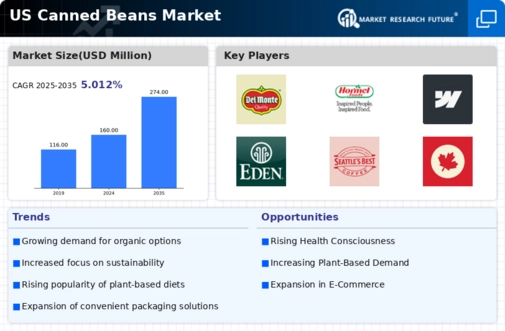Innovations in Product Offerings
Innovation within the canned beans market is driving consumer interest and expanding the range of available products. Manufacturers are increasingly introducing new flavors, organic options, and value-added products, such as beans with added spices or sauces. This diversification caters to evolving consumer tastes and preferences, which seem to be shifting towards more adventurous and flavorful options. Data indicates that the introduction of new product lines can lead to a 15% increase in sales within the first year of launch. As the canned beans market continues to innovate, it is likely to attract a wider demographic, including younger consumers who seek unique and exciting food experiences. This trend towards innovation may ultimately enhance the overall growth trajectory of the industry.
Affordability and Economic Factors
Economic considerations play a crucial role in shaping consumer behavior within the canned beans market. Canned beans are often viewed as a cost-effective source of nutrition, especially during times of economic uncertainty. With an average price point of around $1.50 to $2.00 per can, they provide an affordable protein option for families. Additionally, the rising cost of fresh produce may lead consumers to seek more budget-friendly alternatives, further driving the demand for canned beans. the canned beans market is well-positioned to capitalize on these economic trends, as consumers increasingly prioritize value without compromising on nutrition.. This affordability factor could potentially lead to a sustained increase in market share for canned beans, making them a staple in many households.
Increased Focus on Convenience Foods
The fast-paced lifestyle of modern consumers has led to a heightened demand for convenience foods, significantly impacting the canned beans market. Canned beans offer a quick and easy meal solution, requiring minimal preparation time. This convenience aligns with the preferences of busy families and individuals seeking nutritious options without extensive cooking. Recent surveys indicate that approximately 60% of consumers prioritize convenience when selecting food products. As a result, the canned beans market is likely to see continued growth as manufacturers innovate packaging and product offerings to meet these demands. The industry may also explore ready-to-eat options, further enhancing the appeal of canned beans as a convenient meal choice.
Rising Demand for Plant-Based Proteins
The increasing consumer inclination towards plant-based diets is a notable driver for the canned beans market. As more individuals seek alternatives to animal proteins, canned beans are perceived as a convenient and nutritious option. According to recent data, the plant-based food market in the US has experienced a growth rate of approximately 27% over the past few years. This trend suggests that the canned beans market could benefit significantly, as beans are rich in protein and fiber, appealing to health-conscious consumers. Furthermore, the versatility of canned beans in various recipes enhances their attractiveness, potentially leading to increased sales in the canned beans market. As the trend towards plant-based eating continues, the demand for canned beans is likely to rise, positioning the industry for sustained growth.
Growing Awareness of Nutritional Benefits
Consumer awareness regarding the health benefits of beans is a significant driver for the canned beans market. Beans are recognized for their high fiber content, low fat, and essential vitamins and minerals, making them a desirable food choice for health-conscious individuals. Educational campaigns and nutritional guidelines from health organizations have emphasized the importance of incorporating legumes into diets. This increased awareness appears to be translating into higher sales in the canned beans market, as consumers actively seek out products that contribute to a balanced diet. The industry may benefit from highlighting these nutritional advantages in marketing efforts, potentially attracting a broader audience and fostering brand loyalty among health-oriented consumers.






















Leave a Comment